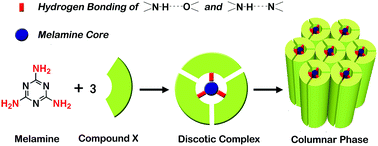Hydrogen-bonding induced melamine-core supramolecular discotic liquid crystals†
Abstract
Recognition of melamine is not only of importance for the food industry but also an interesting scientific research topic. The objective of this work is to screen suitable hydrogen-bonding complementary compounds for the construction of melamine-core supramolecular discotic liquid crystal (LC) materials which might provide a LC perspective for detection and separation of melamine in the future. We design and synthesize five categories of long-alkyl-tailed compounds bearing different hydrogen-bonding complementary functional groups, including benzoic acid, cyanuric acid, homophthalimide, succinimide and thymine derivatives. The experimental results demonstrate that the imidodicarbonyl unit is the best hydrogen-bonding complementary functional group of melamine. Furthermore, the heterocyclic ring size markedly influences the hydrogen-bonding strength of the melamine-imidodicarbonyl unit complex. Most importantly, liquid crystallinity can be generated from these hydrogen-bonding supramolecular complexes. In particular, a variety of columnar mesomorphic orders (such as hexagonal columnar, rectangular columnar, and square columnar phases) can be effectively achieved by functionalization of thymine or succinimide units and modulation of the molar ratios of melamine and these hydrogen-bonding complementary compounds.



 Please wait while we load your content...
Please wait while we load your content...